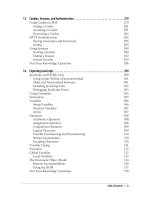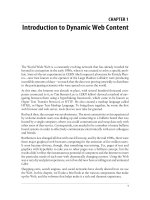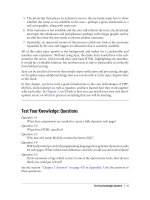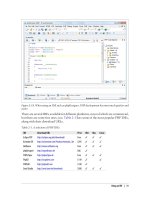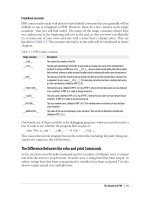Học php, mysql và javascript - p 36 docx
Bạn đang xem bản rút gọn của tài liệu. Xem và tải ngay bản đầy đủ của tài liệu tại đây (1.74 MB, 10 trang )
The ? Operator
The ternary operator (?), combined with the : character, provides a quick way of doing
if else tests. With it you can write an expression to evaluate, then follow it with
a ? symbol and the code to execute if the expression is true. After that, place a : and
the code to execute if the expression evaluates to false.
Example 15-16 shows a ternary operator being used to print out whether the variable
a is less than or equal to 5, and prints something either way.
Example 15-16. Using the ternary operator
<script>
document.write(
a <= 5 ?
"a is less than or equal to 5" :
"a is greater than 5"
)
</script>
The statement has been broken up into several lines for clarity, but you would be more
likely to use such a statement on a single line, in this manner:
size = a <= 5 ? "short" : "long"
Looping
Again, you will find many close similarities between JavaScript and PHP when it comes
to looping. Both languages support while, do while, and for loops.
while Loops
A JavaScript while loop first checks the value of an expression and starts executing the
statements within the loop only if that expression is true. If it is false, execution skips
over to the next JavaScript statement (if any).
Upon completing an iteration of the loop, the expression is again tested to see if it is
true and the process continues until such a time as the expression evaluates to false,
or until execution is otherwise halted. Example 15-17 shows such a loop.
Example 15-17. A while loop
<script>
counter=0
while (counter < 5)
{
document.write("Counter: " + counter + "<br />")
++counter
}
</script>
Looping | 331
This script outputs the following:
Counter: 0
Counter: 1
Counter: 2
Counter: 3
Counter: 4
If the variable counter were not incremented within the loop, it is quite
possible that some
browsers could become unresponsive due to a never-
ending loop, and the page may not even be easy to terminate with Escape
or the Stop button. So be careful with your JavaScript loops.
do while Loops
When you require a loop to iterate at least once before any tests are made, use a
do while loop, which is similar to a while loop, except that the test expression is
checked only after each iteration of the loop. So, to output the first seven results in the
seven times table, you could use code such as that in Example 15-18.
Example 15-18. A do while loop
<script>
count = 1
do
{
document.write(count + " times 7 is " + count * 7 + "<br />")
} while (++count <= 7)
</script>
As you might expect, this loop outputs the following:
1 times 7 is 7
2 times 7 is 14
3 times 7 is 21
4 times 7 is 28
5 times 7 is 35
6 times 7 is 42
7 times 7 is 49
for Loops
A for loop combines the best of all worlds into a single looping construct that allows
you to pass three parameters for each statement:
• An initialization expression
• A condition expression
• A modification expression
These are separated by semicolons, like this: for (expr1; expr2; expr3). At the start of
the first iteration of the loop, the initialization expression is executed. In the case of the
332 | Chapter 15: Expressions and Control Flow in JavaScript
code for the multiplication table for 7, count would be initialized to the value 1. Then,
each time round the loop, the condition expression (in this case count <= 7) is tested,
and the loop is entered only if the condition is true. Finally, at the end of each iteration,
the modification expression is executed. In the case of the multiplication table for 7,
the variable count is incremented. Example 15-19 shows what the code would look like.
Example 15-19. Using a for loop
<script>
for (count = 1 ; count <= 7 ; ++count)
{
document.write(count + "times 7 is " + count * 7 + "<br />");
}
</script>
As in PHP, you can assign multiple variables in the first parameter of a for loop by
separating them with a comma, like this:
for (i = 1, j = 1 ; i < 10 ; i++)
Likewise, you can perform multiple modifications in the last parameter, like this:
for (i = 1 ; i < 10 ; i++, j)
Or you can do both at the same time:
for (i = 1, j = 1 ; i < 10 ; i++, j)
Breaking Out of a Loop
The break command, which you saw to be important inside a switch statement, is also
available within for loops. You might need to use this, for example, when searching
for a match of some kind. Once the match is found, you know that continuing to search
will only waste time and make your visitor wait. Example 15-20 shows how to use the
break command.
Example 15-20. Using the break command in a for loop
<script>
haystack = new Array()
haystack[17] = "Needle"
for (j = 0 ; j < 20 ; ++j)
{
if (haystack[j] == "Needle")
{
document.write("<br />- Found at location " + j)
break
}
else document.write(j + ", ")
}
</script>
Looping | 333
This script outputs the following:
0, 1, 2, 3, 4, 5, 6, 7, 8, 9, 10, 11, 12, 13, 14, 15, 16,
- Found at location 17
The continue Statement
Sometimes you don’t want to entirely exit from a loop, but instead wish to skip the
remaining statements just for this iteration of the loop. In such cases, you can use the
continue command. Example 15-21 shows this in use.
Example 15-21. Using the continue command in a for loop
<script>
haystack = new Array()
haystack[4] = "Needle"
haystack[11] = "Needle"
haystack[17] = "Needle"
for (j = 0 ; j < 20 ; ++j)
{
if (haystack[j] == "Needle")
{
document.write("<br />- Found at location " + j + "<br />")
continue
}
document.write(j + ", ")
}
</script>
Notice how the second document.write call does not have to be enclosed in an else
statement (which it did before), because the continue command will skip it if a match
has been found. The output from this script is as follows:
0, 1, 2, 3,
- Found at location 4
5, 6, 7, 8, 9, 10,
- Found at location 11
12, 13, 14, 15, 16,
- Found at location 17
18, 19,
Explicit Casting
Unlike PHP, JavaScript has no explicit casting of types such as (int) or (float). Instead,
when you need a value to be of a certain type, use one of JavaScript’s built-in functions,
shown in Table 15-6.
334 | Chapter 15: Expressions and Control Flow in JavaScript
Table 15-6. JavaScript’s type-changing functions
Change to type Function to use
Int, Integer parseInt()
Bool, Boolean Boolean()
Float, Double, Real parseFloat()
String String()
Array
split()
So, for example, to change a floating-point number to an integer, you could use code
such as the following (which displays the value 3):
n = 3.1415927
i = parseInt(n)
document.write(i)
Or you can use the compound form:
document.write(parseInt(3.1415927))
That’s
it for control flow and expressions. The next chapter focuses on the use of func-
tions, objects, and arrays in JavaScript.
Test Your Knowledge: Questions
Question 15-1
How are Boolean values handled differently by PHP and JavaScript?
Question 15-2
What character is used to define a JavaScript variable name?
Question 15-3
What is the difference between unary, binary, and ternary operators?
Question 15-4
What is the best way to force your own operator precedence?
Question 15-5
When would you use the === (identity) operator?
Question 15-6
What are the simplest two forms of expressions?
Question 15-7
Name the three conditional statement types.
Question 15-8
How do if
and while statements interpret conditional expressions of different data
types?
Test Your Knowledge: Questions | 335
Question 15-9
Why is a for loop more powerful than a while loop?
Question 15-10
What is the purpose of the with statement?
See the section “Chapter 15 Answers” on page 447 in Appendix A for the answers to
these questions.
336 | Chapter 15: Expressions and Control Flow in JavaScript
CHAPTER 16
JavaScript Functions, Objects, and
Arrays
Just like PHP, JavaScript offers access to functions and objects. In fact, JavaScript is
actually based on objects, because—as you’ve seen—it has to access the DOM, which
makes every element of an HTML document available to manipulate as an object.
The usage and syntax are also quite similar to those of PHP, so you should feel right at
home as I take you through using functions and objects in JavaScript, as well as con-
ducting an in-depth exploration of array handling.
JavaScript Functions
In addition to having access to dozens of built-in functions (or methods) such as
write, which you have already seen being used in document.write, you can easily create
your own functions. Whenever you have a more complex piece of code that is likely to
be reused, you have a candidate for a function.
Defining a Function
The general syntax for a function is:
function function_name([parameter [, ]])
{
statements
}
The first line of the syntax indicates that:
• A definition starts with the word function.
• A name follows that must start with a letter or underscore, followed by any number
of letters, digits, dollar symbols, or underscores.
337
• The parentheses are required.
• One or more parameters, separated by commas, are optional (indicated by the
square brackets, which are not part of the function syntax).
Function names are case-sensitive, so all of the following strings refer to different func-
tions: getInput, GETINPUT, and getinput.
In JavaScript there is a general naming convention for functions: the first letter of each
word in a name is capitalized except for the very first letter, which is lowercase. There-
fore, of the previous examples, getInput would be the preferred name used by most
programmers. The convention is commonly referred to as bumpyCaps.
The opening curly brace starts the statements that will execute when you call the func-
tion; a matching curly brace must close it. These statements may include one or more
return statements, which force the function to cease execution and return to the calling
code. If a value is attached to the return statement, the calling code can retrieve it.
The arguments array
The arguments array is a member of every function. With it, you can determine the
number of variables passed to a function and what they are. Take the example of a
function called displayItems. Example 16-1 shows one way of writing it.
Example 16-1. Defining a function
<script>
displayItems("Dog", "Cat", "Pony", "Hamster", "Tortoise")
function displayItems(v1, v2, v3, v4, v5)
{
document.write(v1 + "<br />")
document.write(v2 + "<br />")
document.write(v3 + "<br />")
document.write(v4 + "<br />")
document.write(v5 + "<br />")
}
</script>
When you call this script in your browser, it will display the following:
Dog
Cat
Pony
Hamster
Tortoise
All of this is fine, but what if you wanted to pass more than five items to the function?
Also, reusing the document.write call multiple times instead of employing a loop is
wasteful programming. Luckily, the arguments array gives you the flexibility to handle
a variable number of arguments. Example 16-2 shows how you can use it to rewrite the
example in a much more efficient manner.
338 | Chapter 16: JavaScript Functions, Objects, and Arrays
Example 16-2. Modifying the function to use the arguments array
<script>
function displayItems()
{
for (j = 0 ; j < displayItems.arguments.length ; ++j)
document.write(displayItems.arguments[j] + "<br />")
}
</script>
Note
the use of the length property, which you already encountered in the previous
chapter, and also how the array displayItems.arguments is referenced using the variable
j as an offset into it. I also chose to keep the function short and sweet by not surrounding
the contents of the for loop in curly braces, as it contains only a single statement.
Using this technique you now have a function that can take as many (or as few) argu-
ments as you like and act on each argument as you desire.
Returning a Value
Functions are not used just to display things. In fact, they are mostly used to perform
calculations or data manipulation and then return a result. The function fixNames in
Example 16-3 uses the arguments array (discussed in the previous section) to take a
series of strings passed to it and return them as a single string. The “fix” it performs is
to convert every character in the arguments to lowercase except for the first character
of each argument, which is set to a capital letter.
Example 16-3. Cleaning up a full name
<script>
document.write(fixNames("the", "DALLAS", "CowBoys"))
function fixNames()
{
var s = ""
for (j = 0 ; j < fixNames.arguments.length ; ++j)
s += fixNames.arguments[j].charAt(0).toUpperCase() +
fixNames.arguments[j].substr(1).toLowerCase() + " "
return s.substr(0, s.length-1)
}
</script>
When called with the parameters “the”, “DALLAS”, and “CowBoys”, for example, the
function returns the string “The Dallas Cowboys”. Let’s walk through the function.
The function first initializes the temporary (and local) variable s to the empty string.
Then a for loop iterates through each of the passed parameters, isolating the parame-
ter’s first character using the charAt method and converting it to uppercase with the
JavaScript Functions | 339
toUpperCase method. The various methods shown in this example are all built-in to
JavaScript and available by default.
Then the substr method is used to fetch the rest of each string, which is converted to
lowercase using the toLowerCase method. A fuller version of the substr method here
would specify how many characters are part of the substring as a second argument:
substr(1, (arguments[j].length) - 1 )
In other words, this substr method says, “Start with the character at position 1 (the
second character) and return the rest of the string (the length minus one).” As a nice
touch, though, the substr method assumes that you want the rest of the string if you
omit the second argument.
After the whole argument is converted to our desired case, a space character is added
to the end and the result is appended to the temporary variable s.
Finally, the substr method is used again to return the contents of the variable s, except
for the final space—which is unwanted. This is removed by using substr to return the
string up to, but not including, the final character.
This example is particularly interesting in that it illustrates the use of multiple properties
and methods in a single expression. For example:
fixNames.arguments[j].substr(1).toLowerCase()
You have to interpret the statement by mentally dividing it into parts at the periods.
JavaScript evaluates these elements of the statement from left to right as follows:
1. Start with the name of the function itself: fixNames.
2. Extract element j from the array arguments representing fixNames arguments.
3. Invoke substr with a parameter of 1 to the extracted element. This passes all but
the first character to the next section of the expression.
4. Apply the method toLowerCase to the string that has been passed this far.
This practice is often referred to as method chaining. So, for example, if the string
“mixedCASE” is passed to the example expression, it will go through the following
transformations:
mixedCase
ixedCase
ixedcase
One final reminder: the s variable created inside the function is local, and therefore
cannot be accessed outside the function. By returning s in the return statement, we
made its value available to the caller, which could store or use it any way it wanted.
But s itself disappears at the end of the function. Although we could make a function
operate on global variables (and sometimes that’s necessary), it’s much better to just
return the values you want to preserve and let JavaScript clean up all the other variables
used by the function.
340 | Chapter 16: JavaScript Functions, Objects, and Arrays

